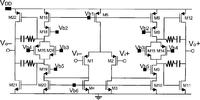jnuhope
Member level 2

high linearity follower
Hi all,
I am designing an opamp for audio application. The opamp needs to achieve high linearity and low noise. For high linearity, resistor type of CMFB seems to be a good candidate, but big resistors introduce noise. My question is what kind of CMFB is good to achieve both linearity and low noise? What's the common CMFB architecture used in audio application?
Thanks everyone in advance!
ps: the CMFB has to be continuous becuz of the application.
Hi all,
I am designing an opamp for audio application. The opamp needs to achieve high linearity and low noise. For high linearity, resistor type of CMFB seems to be a good candidate, but big resistors introduce noise. My question is what kind of CMFB is good to achieve both linearity and low noise? What's the common CMFB architecture used in audio application?
Thanks everyone in advance!
ps: the CMFB has to be continuous becuz of the application.


